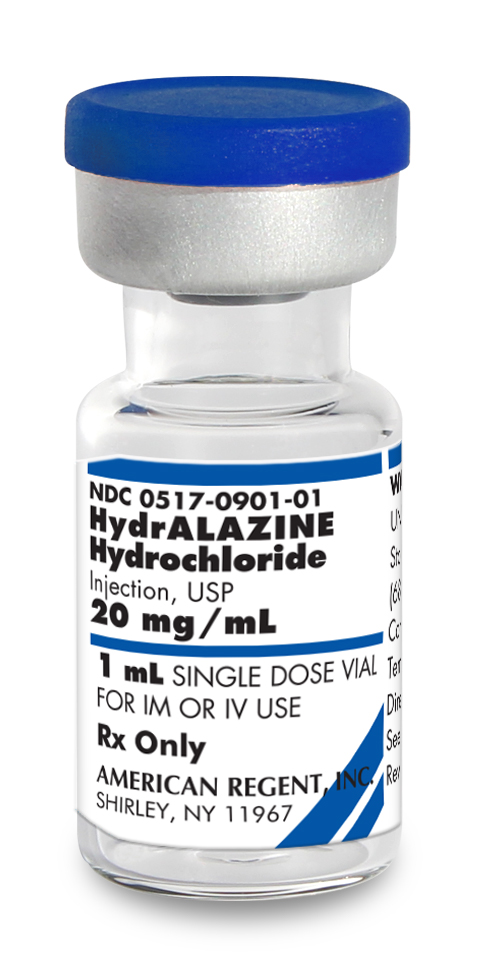Contact Us
By clicking Submit, you confirm that you accept our Privacy Policy and that you agree to your personal contact information being used to contact you and added to our database. If at any time you wish your personal information to be removed from the American Regent® database, please submit a message request to corpcommunications@americanregent.com.
For intravenous and intramuscular administration
INDICATIONS AND USAGE
Severe essential hypertension when the drug cannot be given orally or when there is an urgent need to lower blood pressure.
IMPORTANT SAFETY INFORMATION
CONTRAINDICATIONS
Hypersensitivity to hydralazine; coronary artery disease; mitral valvular rheumatic heart disease.
WARNINGS
Hydralazine may produce a clinical picture simulating systemic lupus erythematosus, necessitating discontinuation unless the benefit-to-risk determination requires continued antihypertensive therapy with this drug. Symptoms and signs usually regress when the drug is discontinued but residua have been detected many years later.
PRECAUTIONS
General: Myocardial stimulation produced by hydralazine can cause anginal attacks and ECG changes of myocardial ischemia including myocardial infarction.
Use with caution in patients with suspected coronary artery disease or advanced renal damage.
Laboratory Tests: Complete blood counts and antinuclear antibody titer determinations are indicated before and periodically during prolonged therapy.
Blood dyscrasias have been reported. If such abnormalities develop, therapy should be discontinued.
Drug Interactions: MAO inhibitors; other antihypertensive drugs.
Pregnancy: Teratogenic effects. Pregnancy Category C:
There are no adequate and well-controlled studies in pregnant women. Hydralazine should be used during pregnancy only if the expected benefit justifies the potential risk to the fetus.
Nursing Mothers: Hydralazine has been shown to be excreted in breast milk.
Pediatric Use: Safety and effectiveness in pediatric patients have not been established.
ADVERSE REACTIONS
The following adverse reactions are not limited to:
Common: Headache, anorexia, nausea, vomiting, diarrhea, palpitations, tachycardia, angina pectoris.
Less Frequent: Digestive: constipation, paralytic ileus
Cardiovascular: hypotension, paradoxical pressor response, edema
Respiratory: dyspnea
Neurologic: peripheral neuritis; dizziness; tremors; muscle cramps; psychotic reactions characterized by depression, disorientation, or anxiety
Genitourinary: difficulty in urination
Hematologic: blood dyscrasias; lymphadenopathy; splenomegaly
Hypersensitive Reactions: rash, urticaria, pruritus, fever, chills, arthralgia, eosinophilia and rarely, hepatitis
Other: nasal congestion, flushing, lacrimation, conjunctivitis
For additional safety information, please see Full Prescribing Information.
You are encouraged to report Adverse Drug Events to American Regent Inc. at 1-800-734-9236, or to the FDA by visiting www.fda.gov/medwatch or by calling 1-800-FDA-1088.
REF-1505 8/2020
